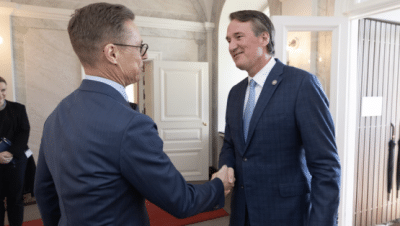
The biggest issue facing college athletics in the NIL era is the competition between athletics departments that need to raise money for scholarships and coaches salaries and NIL collectives that need money to attract and retain student-athletes.
NCAA President Charlie Baker is proposing a radical solution: the creation of a new D1 subdivision that would allow athletes to license their Name, Image and Likeness rights directly to their schools – which, in effect, would allow schools to pay their athletes, without having to give them the status of employees and the related workplace protections.
“Colleges and universities need to be more flexible, and the NCAA needs to be more flexible, too,” Baker, the former Massachusetts governor who took over as president of the NCAA in March, wrote in a letter to college presidents that was made public on Tuesday.
The NCAA hired Baker with the thinking that his political connections could help the college sports business smooth things over with lawmakers on Capitol Hill and in state legislatures, where there has been significant momentum in recent years toward redefining the relationship between college student-athletes and the athletics departments at their schools in favor of empowering the student-athletes.
Baker, apparently, hasn’t been able to get too far with the effort to stem the tide, if the Hail Mary that he flung out in the form of this rather radical proposal is any indication.
Administrators, laughably, have tried to plead poverty whenever the subject of compensation for student-athletes comes into public discussion, this in spite of the billions that flow in from the D1 men’s basketball tournament each year, and the expected additional billions that will start coming in with the expansion of the College Football Playoff from four to 12 teams beginning in 2024.
It doesn’t help from a PR perspective when you see Texas A&M deciding to buy out the $77 million left on the contract of football coach Jimbo Fisher, then hiring Mike Elko on a $7 million-a-year deal with tons of incentives, without batting an eye.
The new D1 subdivision that Baker is proposing would require its member schools to invest at least $30,000 a year for at least half of its countable student-athletes to an educational trust fund that would then be distributed back out to the school’s athletes.
Two important points here: the $30,000 and half the countable student-athletes numbers are the floor, not a ceiling, so athletics fundraisers could certainly do more, and you’d expect that the big boys would do more; and Title IX rules would apply, so at least half of the athletes taking part in the NIL deal would have to be women.
A third point: schools opting in to the new D1 subdivision would be able to work together to create new guidelines regarding roster size, recruiting and the transfer portal – basically, a new set of rules that would apply to just the big boys.
Participation in the new subdivision would not be cheap. At the University of Virginia, for instance, which has in the range of 750 student-athletes in its 27 intercollegiate sports, it would cost $11.25 million a year just to fund the baseline of $30,000 for half its student-athletes.
Even at the floor, that would require UVA Athletics to increase athletics spending by 7 percent over the $161.9 million that the program spent in the 2022-2023 academic sports year, and you would expect schools in Power 5 conferences to do more, almost certainly a lot more.
The benefit to the big boys here: no more competition between the athletics department fundraisers and the NIL collectives for the dollars they need to do their jobs.
Donors could write one check and know they’re helping pay the coaches and pay for scholarships and also putting some money in the pockets of the kids at the same time.
The flip side to this: it would be even more of a challenge for Group of 5 schools like JMU ($57.8 million athletics budget in 2022-2023) and ODU ($53.4 million athletics budget in 2022-2023) to be able to keep up than it is for them now.
Baker acknowledged as much in his letter.
“The growing financial gap between the highest-resourced colleges and universities and other schools in Division I has created a new series of challenges. The challenges are competitive as well as financial and are complicated further by the intersection of name, image and likeness opportunities for student-athletes and the arrival of the Transfer Portal,” Baker wrote in the letter.










